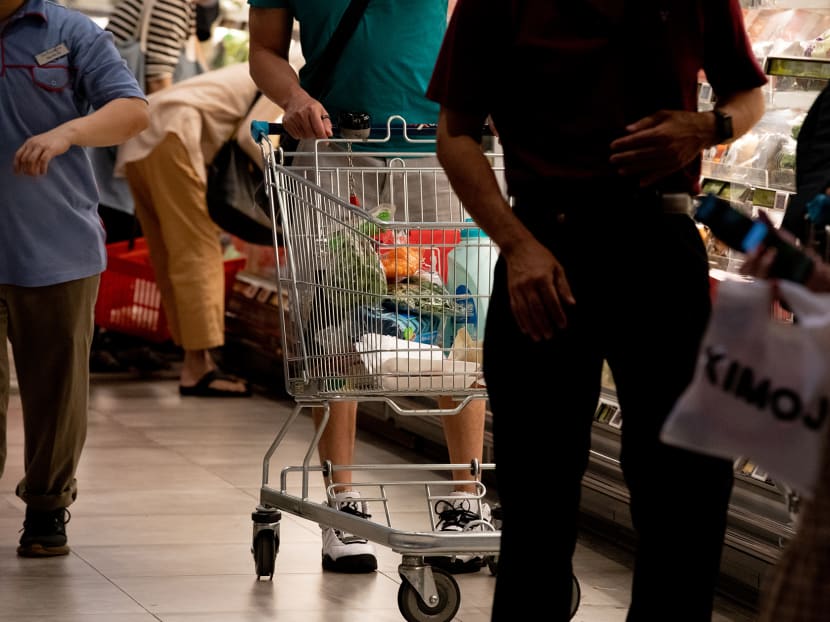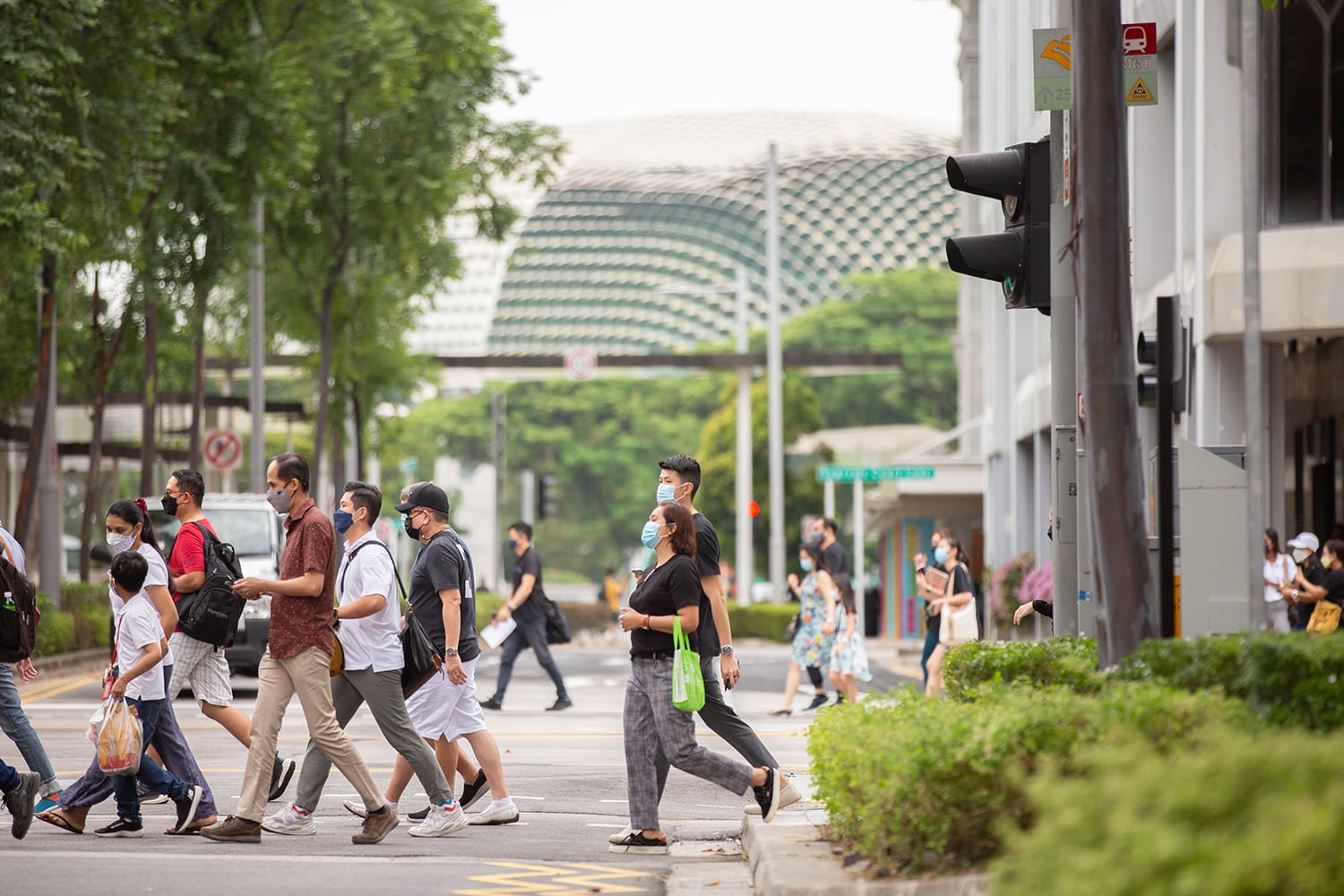The Big Read in short: The threat of stagflation and what it means for you
SINGAPORE — About two to three weeks ago, Mr Kevin Soh noticed that milk powder for his two young children had become S$4 more expensive per tin.

People shop for groceries at a supermarket in VivoCity shopping mall on Jan 30, 2022.
Each week, TODAY’s long-running Big Read series delves into the trends and issues that matter. This week, we look at how rising prices and the Ukraine-Russia war are setting the stage for the rare but dreaded economic phenomenon of stagflation. This is a shortened version of the full feature, which can be found here.
- Inflation has become one of 2022's biggest economic stories globally, including in Singapore
- Already, some in Singapore are feeling the pinch from rising prices and falling income, especially those in sectors yet to recover from Covid-19's impact
- The spectre of a prolonged inflation and protracted war in Ukraine set the stage for a perfect storm threatening to blow the world economy off course
- Policymakers and economists, including Senior Minister Tharman Shanmugaratnam, are increasingly warning that the global economy could go into a rare economic situation known as stagflation, which last occurred in the 1970s
- In such a situation, where a stagnant economy meets high inflation, policymakers are often caught in a bind because the tools they use to counter one of the two ills usually ends up making the other worse
SINGAPORE — About two to three weeks ago, Mr Kevin Soh noticed that milk powder for his two young children had become S$4 more expensive per tin.
A 1.6kg tin for his three-year-old daughter, who consumes two tins a month, now costs S$66, up from S$62. His seven-month-baby son, meanwhile, uses three to four 850g tins a month, and the price for these has hiked from S$46 to S$50 each.
“It’s actually quite taxing on us,” said Mr Soh, 35, who works in marketing.
Beyond milk powder, Mr Soh has also been spending more on other household expenses including food and electricity.
“For the man in the street, they don't need an economist to tell them that their standard of living has been significantly affected in the last few months.Singapore University of Social Sciences economist Walter Theseira”
Taxi driver Andy Guan, 40, has been bearing the brunt of fuel prices that have soared after Russia invaded Ukraine in February.
Fuel hikes since the start of the year caused his earnings to drop by at least 40 per cent. He now intends to stop driving a taxi and start doing food delivery.
“For the man in the street, they don't need an economist to tell them that their standard of living has been significantly affected in the last few months," said economist Walter Theseira, an associate professor at the Singapore University of Social Sciences (SUSS).
“What matters to them has gone up in price — their utility bills, their food, their petrol — and if their wages don't respond soon, their real standard of living will be at risk of declining this year.”
Inflation has become one of 2022's biggest economic stories, not only in Singapore, but also in many countries as a confluence of global events is placing upward pressure on prices.
Inflationary pressures around the world have been building up as economies around the world try to recover from Covid-19, with demand for goods and services returning even as the world’s supply chains have yet to fully recover from pandemic-related disruptions.
The war between Russia and Ukraine could not have come at a worse time: Energy prices in particular have risen sharply over the past year and the conflict has pushed prices up even higher, with Singapore fuel pump prices reaching their highest level on record in recent weeks.
The spike comes as some Western countries such as the US and Canada have decided to halt imports from Russia, the world’s third-largest oil exporter, in response to its military actions. This means they have to buy their oil from other producers, leading to higher prices.
Even as prices rise, the Russia-Ukraine war — along with its economic and political ramifications — looks set to impede or even derail economic recoveries as countries emerge from downturns brought about by Covd-19.

All these are setting the stage for a perfect storm threatening to blow the world economy off course, according to economists and policymakers.
They are even talking about the return of stagflation, which the world has not seen since the 1970s’ oil shock. Combining economic stagnation and inflation, it is a situation where an economy faces the twin challenges of slow economic growth and joblessness amid rising inflation.
At an investment conference last week in Singapore, Senior Minister Tharman Shanmugaratnam warned that the risk of stagflation is very real in many parts of the advanced and developing world.
Calling this an “unprecedented situation”, he said: “We have to plan for a range of scenarios, but tilted very much towards the downside.”
STAGFLATION: WORST OF BOTH WORLDS WHICH BECAME REALITY IN THE 1970s
There was a time when many economists thought it would be impossible to have a situation where a country faced a high inflation rate while grappling with stagnant economic growth and high unemployment.
But stagflation became a bitter reality when the oil embargoes in the 1970s stalled economic growth and sent prices north.
For policymakers, dealing with stagflation is particularly difficult because the tools they use to counter one of the twin problems — high inflation or low growth — usually ends up making the other worse.
Stimulating demand and consumption, for example, would only make inflation worse. But raising interest rates to reduce inflation could hurt growth because it puts the brakes on borrowing and investment.
While the causes of stagflation remain a subject of much debate, one common theory is that it happens when an economy faces a supply shock: An unexpected event causes an important commodity, such as oil, to be in short supply or becomes more expensive.
In such a scenario, prices surge and make production more costly and less profitable, thus slowing economic growth.
“Stagflation is really a problem of a sustained reduction in the standard of living," said Singapore University of Social Sciences economist Walter Theseira. “(This) is worse than a standard recession because you not only have poor or negative growth, but rising prices, so the standard of living drops much faster than in a 'normal' recession.”
The last bout of stagflation is largely believed to be set off by an oil embargo in October 1973 that caused severe gas shortages around the world.
Members of the Organisation of Petroleum Exporting Countries (OPEC) temporarily ceased oil shipments from the Middle East to the US and other countries in retaliation for their support of Israel during the 1973 Arab-Israel war.
Crude oil prices surged from US$3 a barrel in 1970 to US$12 by 1974. The soaring price of fuel choked economic output while pushing up the cost of goods and services, causing high wage demands and spiralling inflation.
The US fell into a recession, recording five straight quarters of negative growth between 1973 and 1974, and unemployment peaked at 9 per cent in May 1975. Inflation, meanwhile, hit double-digit levels in the country in 1974.
In Singapore, higher oil prices drove headline inflation to almost 20 per cent in 1973 and around 30 per cent year-on-year in the first half of 1974. The Republic's gross domestic product (GDP) growth rate fell from 10.6 per cent in 1973 to 6.1 per cent in 1974.
Faced with the prospect of stagflation, the Monetary Authority of Singapore (MAS) implemented several monetary policy measures aimed at curbing inflation, including raising banks’ statutory reserve requirement from 5 per cent to 9 per cent, imposing credit ceilings on banks and finance companies as well as hiking interest rates by 2 percentage points.
By the second half of 1974, inflation started moderating and MAS gradually eased monetary policy to support growth. Singapore's economy avoided a recession and managed to grow 4 per cent in 1975, while headline inflation for the year was 2.6 per cent.
WILL THE GHOST FROM 1970s RETURN?
With the Russia-Ukraine conflict threatening to reshape the international economic landscape, professional investors around the world are growing increasingly worried about the outlook for global growth.
In the Bank of America’s latest Global Fund Manager Survey, which canvasses the views of fund managers managing about US$1 trillion (S$1.36 trillion) in assets every month, 62 per cent of respondents said they forecast stagflation, more than double from February’s reading of 30 per cent.
While Singapore-based economists TODAY spoke to were not expecting stagflation based on the current economic situation, some of them noted the increased risk of such a situation playing out.
Mr Hartmut Issel, UBS Wealth Management’s head of Asia Pacific equities and credit, said that the bank’s base case is that there will not be stagflation in the US.
And given Singapore’s economic links to the global economy, the bank also does not think it will happen here, he said.
“The (US Federal Reserve) made it very clear now… that they are determined to tackle the potential predicament early on while the US economy is still growing above trend rates,” he said, adding that some drivers of inflation in the US are showing early signs of abating.
“If one assumes the Fed gets the trade-off right where both inflation and GDP growth speed are moderating in the second half of this year, it is natural to extend this trend to Singapore.”
Earlier this week, the US Federal Reserve raised its benchmark interest rate for the first time since 2018 and signalled additional rate hikes that would bring the rate to a range between 1.75 per cent and 2 per cent at the end of the year.
Before this, interest rates had been pinned to zero since the start of the Covid-19 pandemic in a bid to cushion the blow of a deep recession.
CIMB Private Banking economist Song Seng Wun believes it is too early to tell if growth in Singapore’s economy will slow or unemployment will rise in the coming months, though it is a situation the bank is watching out for.
The labour market is still supportive of wage growth, though some sectors are faring better than others, he said.
Mr Song added: “Though inflation has gone up, motorists complain but they still fill up the tank. You and I still carry on living life as per normal, whether that’s (spending on) food and beverages or say, travel. So it’s a slight moderation (in confidence) rather than a complete pullback in activities.”
“I am not discounting the possibility (of stagflation). There are some pre-conditions that are gradually emerging and we are not at that stage yet.DBS senior economist Irvin Seah”
DBS Bank senior economist Irvin Seah said that even if there is a slowdown in growth from last year and a pick-up in inflation in Singapore, it may not mean that the country is in stagflation.
Rather, he sees it as a transient normalisation process as the economy reopens from the pandemic.
“I am not discounting the possibility,” Mr Seah said. “There are some pre-conditions that are gradually emerging and we are not at that stage yet.”
Economist Selena Ling, head of treasury research and strategy at OCBC Bank, said that while she believes the probability of stagflation happening has risen, she does not see any outright recession risks outside of the directly impacted economies of Russia and Ukraine.
Major economies such as the Eurozone will take a hit from higher prices, especially energy-related, and face greater supply chain disruptions for a whole slew of commodities including food, metals and neon, she said.
“But the labour markets of the US and also Singapore are actually in healthy shape,” she added.
IMPACT OF STAGFLATION IF IT COMES TO PASS
If global inflation remains high over the next few months and workers around the world start to realise that their cost of living has outpaced their wage growth, then they may start to pare back on their spending.
Economic activities all over would then start to slow as more people feel the impact of higher costs. Consequentially, hiring would begin to slow.
This is where stagflation starts making its presence felt.

SUSS’ Assoc Prof Theseira said that the sustained reduction of living standards would put hundreds of millions of people globally into or almost into poverty, and harm the ability of developing economies to join the ranks of the middle-income nations.
“It would likely precipitate political crises globally and even regionally,” he said.
Mr Song said that when inflation is brought about by domestic factors, such as high rental prices or labour costs, policymakers in Singapore have more tools to bring it down — such as by tightening down on speculation or tweaking foreign worker policies.
But when prices are high due to supply factors outside of Singapore’s control, as is the present case, then it becomes harder to clamp down on inflation.
Nevertheless, Mr Song said that if wage demands by workers to cope with the higher standard of living becomes too high for businesses, the Government could also cut employers’ Central Provident Fund contributions, which was what happened during the recession in 1986.
When an economy falls into stagflation, Assoc Prof Theseira said that it often forces policymakers to consider policy options that may be highly damaging to the economy and people’s lives, and yet these may still be better than risking prices spiralling upwards without growth.
At the end of the 1970s, for example, the US Fed used extremely high interest rates to tame inflation. In Singapore, responses to historic recessions such as the early 1980s recession — widely attributed to wage increases being too sharp and out of sync with growth — have also involved radical policies such as sharply cutting or freezing wages.
“The policies to correct a severe economic crisis are invariably painful, but may be necessary medicine. Let's hope it doesn't come to that,” said Assoc Prof Theseira.
Stagflation, if it occurs, would also put the MAS in a fix — should it tighten or ease monetary policy?
In such a scenario, Mr Seah said he sees a strong role for fiscal policy through the use of government spending.
For example, Singapore could introduce a supplementary Budget to support growth, while the central bank eases monetary policy a little, but maintains a gradual currency appreciation to tame inflation.
Stagflation would also be a huge blow to the global and domestic economies, coming so close on the heels of the pandemic.
Indeed, the rising cost of living has already taken a toll on some workers in sectors hit hard by the pandemic over the past two years.

For some, like hawkers Elayne Ang, 41, and her husband Samuel Tan, 37, the inflation is hitting them hard even as their business has yet to recover from the pandemic.
The stallholders of Tian Kee Carrot Cake at Block 84 Marine Parade Central Market and Food Centre had increased the price of their carrot cake on Jan 1 from S$3.50 to S$4 to keep pace with rising costs of ingredients.
But since Russia invaded Ukraine three weeks ago, the costs have soared even further.
Meanwhile, their business continues to be affected by the safe distancing measures in place at eateries: The capacity of the hawker centre they are operating at has been capped at 250, instead of its full capacity of 800.
“We can’t possibly increase (prices) by another 50 cents, that’s not fair to the consumer," said Ms Ang.
“All these economic uncertainties over the past years made me feel that I have to continuously earn money... At the same time, it’s very hard to juggle because we want to find a balance between work and family.Mr Kevin Soh, 35, a marketing professional who works almost seven days a week including emceeing at weddings on weekends”
For Mr Soh, the father of two, he considers himself lucky that his household finances — which his wife also contributes to — have been holding up well amid the rising cost of household expenses.
“All these economic uncertainties over the past years made me feel that I have to continuously earn money in order to make sure life is sustainable,” said Mr Soh, who has been working almost seven days a week including emceeing at weddings on weekends.
“If the war continues and the (shortage) of semiconductors kicks in, then will it affect my industry and job stability? All this adds up and snowballs to the fear that we are facing,” he added.








